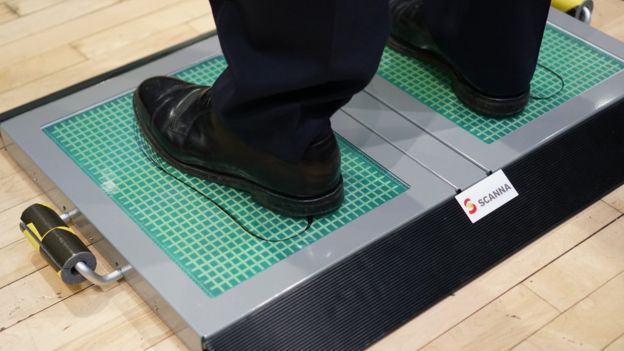The next step in airport security
- Transfer

Bag, visible through X-ray scanner
Technologies that can speed up and increase the efficiency of airport security checks were shown to industry experts at a demonstration event in London.
The event is part of the Future Aviation Security Solutions ( FASS ) government program , which is investing millions of pounds in promising ideas.
It should be noted that almost all the innovations presented are still at the prototype stage.
Among the innovations presented is a platform that can detect explosives hidden in the shoes of people queuing for security checks. The shoe scanner developed by Scanna uses a grid of sensitive electrodes to analyze the shoe and its contents. When the machine detects something that should not be in a pair of shoes, it warns the staff so that it can intervene.

Since this unit takes only a few seconds to work, the company hopes that the device can be integrated with full-body surveys with scanners so that passengers no longer need to take off their shoes at the airport.
This technology may well be used on passengers waiting in line for security checks. The company hopes to try it out by the end of 2019.
Deep pockets
Another company, Sequestim, hopes to save you from having to take things like cell phones and wallets out of your pockets.
The company is working on combining artificial intelligence with a more sensitive version of the millimeter-wave scanners that are already used at airports.
Sequestim hopes that this will enable passengers to pass through scanners with full pockets, and still be able to identify hidden threats.
According to a company representative, cooling the sensor to -273 degrees Celsius increases its efficiency and allows you to scan passengers at a distance of up to 8 meters.
Despite the fact that cooling costs are quite expensive, the airport may consider this technology to be recouped, having the opportunity to save time on checking passengers.
The company claims that its artificial intelligence will allow passengers to leave their belongings in their pockets, since the system will distinguish ordinary objects that do not pose a danger from those that should be looked at more closely.
“This will not eliminate the need for manual verification, but will speed up the process by reducing the number of trays passing through the scanners,” said Rob Spurrett, managing director of Sequestim.
Deep learning
Researchers at Durham University hope that their system will save passengers from having to remove electronics and liquids from the bags in the cabin during safety checks. They develop artificial intelligence that can analyze images from x-ray scanners at the airport and identify anything that looks suspicious.
Such a system recognizes, for example, what a typical laptop looks like, and recognizes whether it has been modified to contain materials that the system has never seen in any other laptop before.
Meanwhile, researchers at the University of Cambridge were looking for the best way to train airport security personnel. They suggest that teaching people to detect prohibited items on X-ray images can be illogical, since the most serious threats are also images that are less likely to have never been seen before at all.
Future goals

Portable security scanner developed by UCL
One of the ideas presented by University College London was a portable security scanner that can determine what materials the item was made from. Developers are hoping that the technology can be implemented over the next five years so that the scanner can reliably find prohibited items, even if they are hidden in bags, without the need for X-rays.
